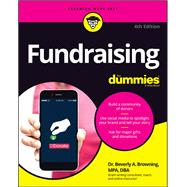Follow the mission and the money, even when it takes you online
Fundraising For Dummies is your guiding light and saving grace as you prepare and implement a fundraising plan. This updated edition will help you succeed at fundraising in the age of social media saturation. You’ll discover how to post, what to include, and where to interact to get the biggest return on your investment of time. And, as always, this trusted resource covers all the basics of being a fundraiser, soliciting the money an organization needs, and pitching the case statement for your organization. Use real-life examples to take your own fundraising skills to the next level and follow step-by-step processes for success in online fundraising.
- Learn what’s involved in the role of a nonprofit fundraiser
- Discover sources of funding for your organization—and learn how to secure that funding
- Use the latest online fundraising tools and social media techniques to reach out to audiences
- Make fundraising easy with examples and templates for donor letters and beyond
Fundraisers (including board members, volunteers, and staff members) in any nonprofit organization will love this easy-to-follow advice on getting creative about donations.









